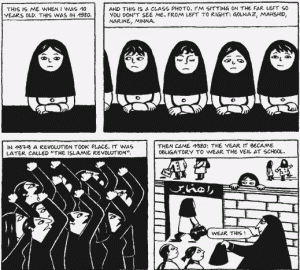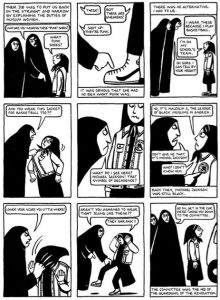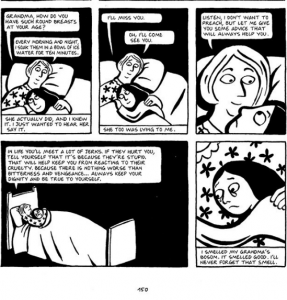I had an amazing time reading Persepolis for my ASTU class last week. Persepolis is a graphic memoir by Iranian graphic novelist, Marjane Satrapi. Satrapi tells her own story of growing under the fundamentalist Islamic regime in Iran after the Islamic Revolution of 1979 through the perspective of a young girl, Marji. The book addresses several important themes, such as gender and class inequality, religion, and memory. However, the theme that jumped out to me was that of identity.
I found Satrapi’s portrayal of how Marji navigates the conflict between conforming to the community norms established under the pressures of the fundamentalist regime and retaining and expressing her individuality quite noteworthy. Satrapi does this through three major symbols: the veil, Marji’s relationship with religion, and Marji’s family.

Satrapi uses the veil as a significant symbol for loss of identity in Persepolis. The veil is often (wrongfully) associated with oppression in Western societies. Satrapi uses this notion to show how the regime tried to take away women’s identity in war-torn Iran by forcing them to retreat from public spheres and cover themselves up. But Satrapi also highlights that even though it may seem like it worked (as indicated by the pictures of all women in the book wearing veils), the oppressive laws were at least not entirely successful in making everyone believe in the laws’ legitimacy, as shown by Marji’s and her family’s refusal to comply to them. Satrapi gives us the first insight into how Marji sees herself in relation to others in the very first panel of the comic on page 1. Here, I found Satrapi’s choice to draw two frames instead of one as quite clever. The first frame shows Marji’s classmates and the second one shows Marji alone. Two things that struck me here are how all the girls are wearing veils and how the girls in the second frame look almost identical. I think this symbolises homogeneity of thought and compliance with the laws of the Islamic regime. Through this, Satrapi tries to show how Marji considered herself as a part of the group of girls in her class who were feeling oppressed and silenced in the same ways as her (and the rest of Iranians) and yet viewed herself as a different and unique individual with her own experiences of the threat the regime’s rules posed to her identity.

Satrapi also shows how Marji sometimes wears symbols of Western culture, which she has grown up liking and internalising as a part of her identity, under her veil. For example, on page 133, she goes out wearing a denim jacket, jeans, and jewellery to buy tapes of American music. In spite of being repeatedly told by the regime to give up these “Western objects” as they are “against the religion”, she continues to hold possession of these objects and interests that make her who she is. When she is caught and reprimanded for wearing these, she is visibly shaken and angry because those are crucial parts of who she is and she does not want to give up these parts of her identity.
Satrapi also highlights how Marji’s relationship with religion is a huge part of her identity by giving us insights into Marji’s notion of her religion and her relationship with God. Marji has her own conception of religion which differs quite significantly from that of the regime and despite the considerable influence of the government’s extremist propaganda, her notion of religion does not change to align with Islamic fundamentalism. It is also striking how none of her parents is religious, so Marji’s (what would be considered unique under the circumstances) idea of religion is a great show of her individuality. She describes herself as “born with religion”. Her religion does not ask women or men to dress a certain way, oppress the poor, prohibit Western lifestyles, and most importantly, allows for a female God. Satrapi shows how Marji believes herself to be “the last prophet” and follow values that she has deemed the most important through her own observations, such as economic equality, even when she is discouraged by her teacher for the ridiculousness of her ideas.

In my Sociology class, we recently studied the concept of self-identity and how it is constructed through our relationships and interactions with others. Clearly, a big reason why Marji’s connection with her own identity was so deep and stable was that it was constantly reinforced and encouraged by her immediate environment, that is, her family. Satrapi makes a huge point of this by repeatedly illustrating throughout the book how her parents encouraged and even facilitated her independent thinking and individuality. For example, Marji’s parents did not disapprove of her ambitions to become God, provided her with many books so she could develop informed values and opinions, and acted as good role models by themselves retaining their individual beliefs and being actively involved in the resistance. It was because they refused to give up their own identity and values that Marji could develop a strong sense of self too. Had they accepted the fundamentalist Islamic ideas, Marji would have been forced to change who she is and would not have had a strong identity. We can also see that her grandmother plays a similar role, especially on page 150. Right before Marji leaves for Austria, her grandmother tells her to “always be true to herself.”: a message Marji carries with herself.
I think this message is exactly how Satrapi approached writing this book. Yes, she is telling the story of the Iran war and how the citizens were affected by it. But ultimately, she repeatedly implies throughout the book that this is HER story. This is the expression of her identity as it developed during the years she spent living under an oppressive government in a war-torn Iran. Persepolis is Satrapi’s attempt to resist and express her identity and it is directed not just towards the oppressive regime that tried to take it away, but also towards the stereotypical Western notion of all Iranians as “violent, Islamic fundamentalists and terrorists”. It is unique and individual and provides us with a new perspective of Iran and the Iranians.
Additionally, whether Satrapi intended for the book to serve this purpose or not, Persepolis definitely made me think about my own identity and what values and things I associate myself with. Ever since I moved to Vancouver from India, I have found myself trying to figure myself out more than ever before. I have experienced the conflict between identifying more strongly with my culture as an attempt to retain a connection to home, which has become so much more important to me now that I am a minority in another country, and exploring myself as an individual by fully immersing myself into all the new opportunities and situations I am encountering here. Reading Persepolis made me realize the importance of putting conscious effort into this process of self-discovery and regularly checking in with myself to ensure that I am being true to myself in whatever I do. I certainly look forward to coming back to this blog post at the end of my first year with a surer sense of who I am.

